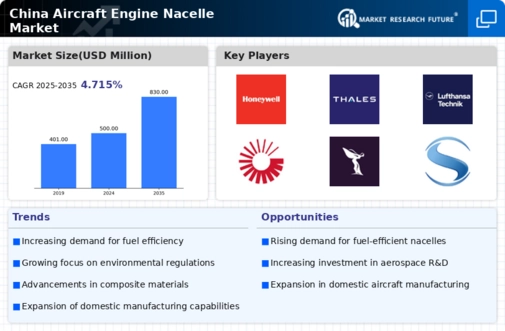Rising Demand for Air Travel
The aircraft engine-nacelle market in China is experiencing a notable surge in demand due to the increasing number of air travelers. With the Civil Aviation Administration of China (CAAC) projecting a growth rate of approximately 6.5% annually in passenger traffic, airlines are compelled to expand their fleets. This expansion necessitates the procurement of advanced engine-nacelle systems, which are critical for enhancing aircraft performance and fuel efficiency. As a result, manufacturers in the aircraft engine-nacelle market are likely to invest in innovative designs and materials to meet the evolving needs of airlines. Furthermore, the growing middle class in China is contributing to this trend, as more individuals are able to afford air travel, thereby driving the demand for new aircraft and, consequently, engine-nacelle systems.
Technological Innovations in Nacelle Design
Technological innovations are playing a pivotal role in shaping the aircraft engine-nacelle market in China. Advances in materials science and engineering are enabling the development of lighter and more efficient nacelle designs. For instance, the use of composite materials is becoming increasingly prevalent, as they offer superior strength-to-weight ratios compared to traditional materials. This shift is likely to enhance the performance of aircraft while simultaneously reducing fuel consumption. Additionally, innovations in noise reduction technologies are becoming essential, as regulatory bodies impose stricter noise standards. As a result, manufacturers in the aircraft engine-nacelle market are expected to invest in research and development to create cutting-edge nacelle systems that meet both performance and regulatory requirements.
Emergence of Domestic Aircraft Manufacturers
The emergence of domestic aircraft manufacturers in China is reshaping the landscape of the aircraft engine-nacelle market. Companies such as COMAC are making strides in developing indigenous aircraft, which necessitates the integration of advanced engine-nacelle systems. This trend is likely to foster competition among suppliers, leading to innovations in nacelle technology. Furthermore, the Chinese government's support for local manufacturers through subsidies and favorable policies is expected to enhance the capabilities of these companies. As domestic production increases, the aircraft engine-nacelle market may experience a shift towards localized supply chains, potentially reducing costs and improving delivery times for nacelle systems.
Focus on Fuel Efficiency and Emissions Reduction
In the context of the aircraft engine-nacelle market, there is a growing emphasis on fuel efficiency and emissions reduction in China. The government has set ambitious targets to reduce carbon emissions from the aviation sector, aiming for a 50% reduction by 2030 compared to 2005 levels. This regulatory environment is driving manufacturers to innovate and develop more efficient nacelle designs that can accommodate next-generation engines. As airlines seek to comply with these regulations, the demand for advanced nacelle systems that enhance aerodynamic performance and reduce drag is likely to increase. Consequently, the aircraft engine-nacelle market may witness a shift towards lightweight materials and advanced manufacturing techniques to meet these stringent requirements.
Government Investment in Aviation Infrastructure
The Chinese government is significantly investing in aviation infrastructure, which is poised to bolster the aircraft engine-nacelle market. Initiatives such as the construction of new airports and the expansion of existing ones are expected to enhance the overall capacity of the aviation sector. According to the National Development and Reform Commission (NDRC), investments in aviation infrastructure are projected to exceed $100 billion over the next five years. This influx of capital is likely to stimulate demand for new aircraft, thereby increasing the need for advanced engine-nacelle systems. Additionally, the government's focus on modernizing air traffic management systems may further enhance operational efficiency, indirectly benefiting the aircraft engine-nacelle market by promoting the adoption of newer aircraft models equipped with state-of-the-art nacelle technologies.



















Leave a Comment